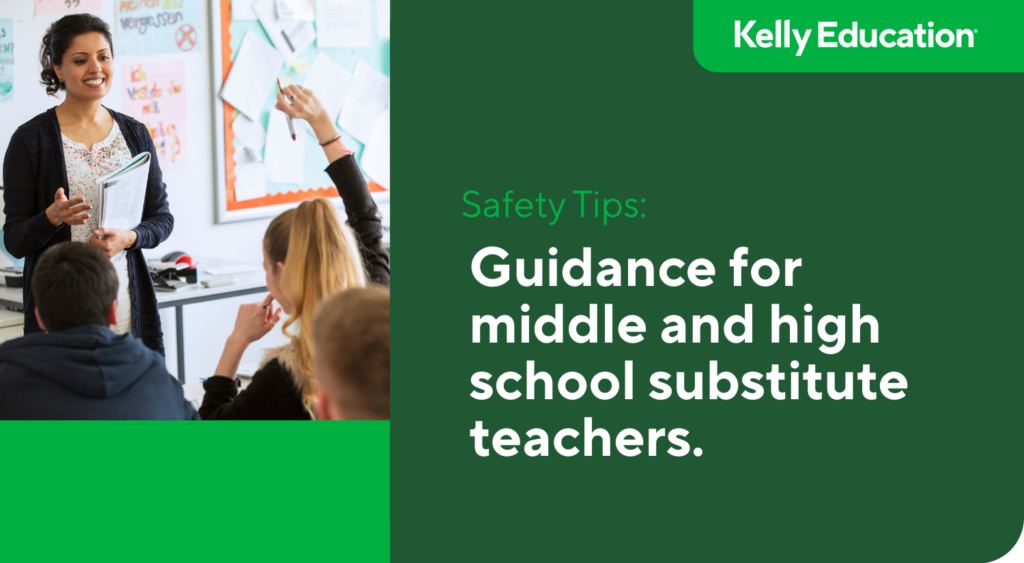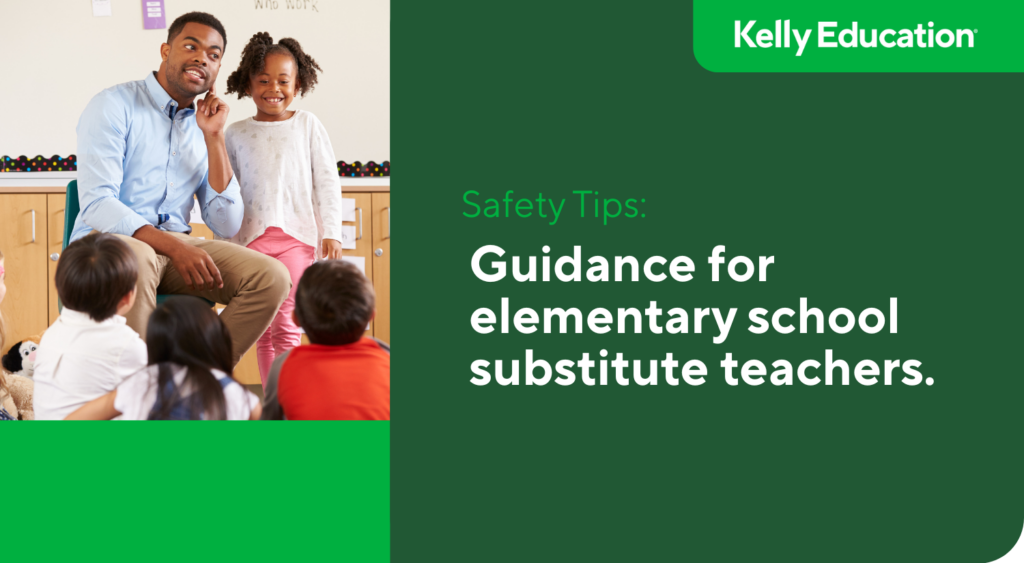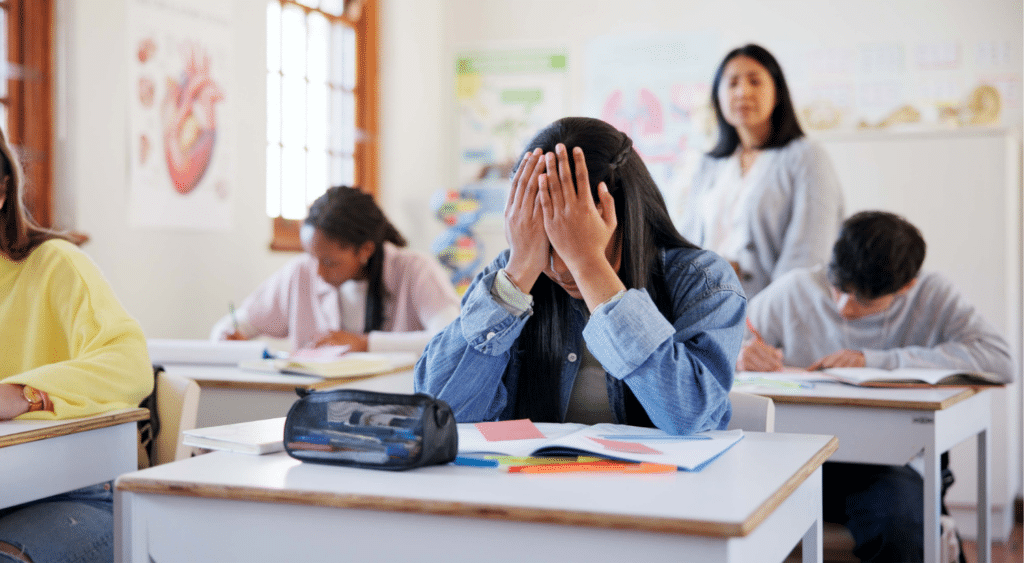Common school safety concerns for substitute teachers – middle & high school.

Ensuring safety in middle and high schools isn’t just important—it’s essential, especially for substitute teachers and support staff. Whether you’re navigating crowded hallways, passing by the chemistry lab, or dodging flying balls at recess, staying alert is crucial.
A safe and healthy school environment not only keeps you protected but also sets you up to be your most effective and productive self as a substitute teacher.
Common hazards for teachers in all grades.
Regardless of where, what subject, or what grade you teach, there are specific hazards of which all teachers should be aware.
- Slips and falls. Water, snow, ice, cracks in parking lot pavement, uneven surfaces, stairs, and paper and other trash on floors can easily lead to slips and falls. Texting or reading an interesting story on your phone can wait. Keep your head up and watch where you’re going. Wear sensible shoes with rubber soles—no sandals, high heels, or open-toed shoes.
- Heavy lifting. Moving desks, tables, stacks of books, heavy boxes, or other supplies can lead to injury. If heavy objects need to be moved, ask for help. Also, avoid getting up on tables or chairs to reach high places.
- Eye strain. Excess screen time—whether you’re looking at a computer monitor or mobile device—can put a lot of strain on your eyes. Blurry vision, astigmatism, headaches, and even migraines can result. Take frequent breaks from the screen and adjust the brightness to a comfortable level. Eye strain can also be caused by working in a low-light environment, so be sure your workspace is well lit.
- Germs and bacteria. Students sometimes come to school when sick, even if they don’t have any apparent symptoms. Take reasonable precautions to avoid contact with bodily fluids, including saliva, tears, mucus, urine, and especially blood. If any of these substances are found on a surface or the floor, take proper measures to protect yourself when cleaning up, or send for a custodian.
Let’s look at a few hazards you may see specifically as a middle or high school teacher.
Fights and violence.
As much as we wish they didn’t happen, fights between students have been occurring ever since the very first one-room schoolhouse.
You risk real injury if you get involved in a fight. You may become the unintentional victim of kicking, punching, hair-pulling, scratching, and even biting. A student may even have a concealed weapon.
- If students get into a fight, do not intervene physically. Immediately call school security or administration to handle the situation.
- If not included in the teacher’s note to you, ask administrators if any students in your class have known behavioral issues. If so, ask about the best de-escalation techniques.
- Keep in mind that students who have difficulty controlling themselves physically or emotionally can lash out, even unintentionally, and cause bruises, cuts, and worse. If a student is becoming overly agitated, seek assistance from counselors or administrators right away.
Subject-related hazards.
Depending on the subject you’ve been asked to teach, safety in middle schools and high schools may require some pivoting to alternatives. Administrators and teachers will know this and should leave you with a back-up plan.
- Science Experiments with Chemicals. Kelly Education educators are prohibited from leading or participating in lesson plans that involve chemicals. You’ll need alternative lesson plans.
- Fire. Some classes, such as welding, chemistry, and culinary arts, use fire regularly in middle and high school. Again, Kelly Education educators are prohibited from leading or participating in lesson plans that involve fire or accelerants.
- Tools and machinery. Shop classes require students to work with machinery such as lathes, milling machines, drill presses, band and table saws, air tools, and other power tools. This equipment can cause severe injury and even death if misused. That’s why (you guessed it) Kelly educators are not to lead or participate in these lessons.
- Physical Education (aka gym class). Avoid the temptation to participate with the students. You may not be in proper physical condition, or you might accidentally collide with a student. You could also get hit with a baseball, basketball, volleyball, hockey puck, etc. Additionally, you may not be dressed appropriately for sports or physical activity. Remember, you’re there to supervise, not participate.
Even if you have previous training and feel confident with these types of lessons/curriculums, you should not do them! If there is a question, please reach out to your Kelly representative.
Emergency situations.
A natural disaster, fire, or lockdown can occur suddenly and unexpectedly. The school likely has procedures and protocols in place to deal with them, so be sure to familiarize yourself with them at the start of the school day. In fact, we ask our educators to ask about these procedures every time they take an assignment. Things change – even if you’ve been in the same building before!
While there isn’t a script to deal with every emergency that may arise, you should be familiar with evacuation routes and procedures as well as shelter-in-place instructions.
Grow as a Kelly Education substitute teacher.
At Kelly Education, we want you to become the very best substitute teacher you can be. That’s why we’ve built an entire library of helpful articles for substitute teachers. To get started, check these out:
- Complete guide to becoming a substitute teacher
- How to tackle emergency procedures as a substitute teacher
- What not to do as a substitute teacher
If you’re looking for flexible work that will give you a true sense of accomplishment and satisfaction, look no further. Fill out our brief interest form, and one of our Kelly Education recruiters will reach out to you and discuss opportunities with one of our school district partners.
*This article contains common guidance and is not a comprehensive list of policies or procedures outlined in the Kelly Education handbooks.
View Related: Article Workplace culture
You might like
Find your next job
Discover thousands of temporary, full-time, and remote jobs for beginning and experienced job seekers.



